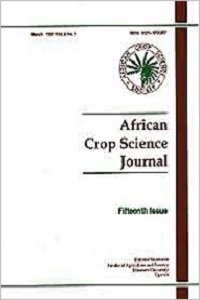Reaction of selected common bean genotypes to physiological races of Phaeoisariopsis griseola occurring in Kenya
The wide pathogenic variability occurring in Phaeoisariopsis griseola, the causal agent of angular leaf spot of common bean (Phaseolus vulgaris L.), dictates that new sources of resistance be continuously identified. This study was undertaken to determine the reaction of selected bean genotypes to different races of P. griseola in order to identify potential sources of resistance to angular leaf spot. Selected bean genotypes from Eastern and Central Africa Bean Research Network (ECABREN) and National Dryland Farming Research Centre (NDFRC), Katumani in Kenya were separately inoculated with forty-four races of P. griseola and evaluated for disease development under greenhouse conditions. The genotypes included small- and large-seeded types. None of the genotypes was resistant to all the races, indicating a high complexity of the pathogen population. Thirteen genotypes were resistant (disease score 1 to 3) or moderately resistant (score 4 to 6) to at least 40 of the races. Small-seeded bean genotypes ECAB 0754 and ECAB 0617 were resistant or moderately resistant to all races except Mesoamerican race 33-39 and Afro-Andean race 58-18, respectively. Genotype ECAB 0754 exhibited the highest level of resistance, with an average disease severity of 1.1%. All the resistant or moderately resistant genotypes were of the small-seeded bean types which are commercially less popular. The commonly grown large-seeded genotypes were generally susceptible. Among the bean genotypes evaluated, the small-seeded pintos and browns/yellows possessed high levels of resistance. The results of this study indicate that different bean genotypes have varying levels of resistance to angular leaf spot that can be pyramided into appropriate background to provide durable resistance.

